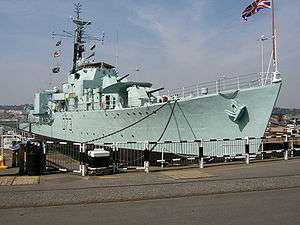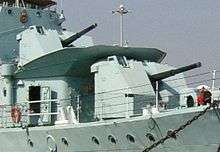HMS Cavalier (R73)
 HMS Cavalier, September 2005, as she appears at Chatham Dockyard. | |
| History | |
|---|---|
| Name: | HMS Cavalier |
| Builder: | J. Samuel White and Company, Cowes, Isle of Wight |
| Laid down: | 28 March 1943 |
| Launched: | 7 April 1944 |
| Commissioned: | 22 November 1944 |
| Decommissioned: | 1972 |
| Identification: | Pennant number: R73 (later D73) |
| Fate: | Preserved as a museum ship since 1998 |
| General characteristics | |
| Class and type: | C-class destroyer |
| Displacement: | 1,710 tons (standard) 2,520 tons (full) |
| Length: | 363 ft (111 m) o/a |
| Beam: | 35.75 ft (10.90 m) |
| Draught: | |
| Propulsion: |
|
| Speed: | 37 knots (69 km/h) |
| Range: | 615 tons oil, 1,400 nautical miles (2,600 km) at 32 knots (59 km/h) |
| Complement: | 186[1] |
| Armament: |
|
HMS Cavalier is a retired C-class destroyer of the Royal Navy. She was laid down by J. Samuel White and Company at East Cowes on 28 March 1943, launched on 7 April 1944,[1] and commissioned on 22 November 1944.[3] She served in World War II and in various commissions in the Far East until she was decommissioned in 1972. After decommissioning she was preserved as a museum ship and currently resides at Chatham Historic Dockyard.[4]
Construction
Cavalier was one of 96 War Emergency Programme destroyers ordered between 1940 and 1942. She was one of the first ships to be built with the forward and aft portions of her hull welded, with the midsection riveted to ensure strength. The new process gave the ship additional speed. In 1970 a 64-mile race was arranged between Cavalier and the frigate Rapid, which had the same hull form and machinery. Cavalier beat Rapid by 30 yards (27 m) after Rapid lifted a safety valve, reaching an average speed of 31.8 knots (58.9 km/h).[2]
Service history

After commissioning she joined the 6th Destroyer Flotilla, part of the Home Fleet, and took part in a number of operations off Norway. Most notably in February 1945 she was despatched with the destroyers Myngs and Scorpion[5] to reinforce a convoy from the Kola Inlet in Russia, which had suffered attacks from enemy aircraft and U-boats, and had subsequently been scattered by a violent storm. She and the other escorts reformed the convoy, and returned to Britain with the loss of only three of the thirty-four ships. This action earned Cavalier a battle honour.[3]
Later in 1945 Cavalier was despatched to the Far East, where she provided naval gunfire support during the Battle of Surabaya. In February 1946 she went to Bombay to help quell the Royal Indian Navy Mutiny. After some time in the British Pacific Fleet she was paid off in May 1946 and was placed in reserve at Portsmouth.[5]
Cavalier returned to service in 1957 after a modernisation, which included removing some of her torpedo tubes in favour of Squid anti-submarine mortars. She was again sent to the Far East, and joined the 8th Destroyer Squadron in Singapore. In December 1962 she transported 180 troops from Singapore to Brunei to help suppress a rebellion that became part of the Indonesia-Malaysia Confrontation. After disembarking the troops she remained in Brunei as a communications centre for several days until other Royal Navy ships arrived to relieve her.[6]
Cavalier was decommissioned in 1972 along with HMS Wellington (moored in London), and is the last surviving British destroyer of World War 2.
After decommissioning
After decommissioning at Chatham Dockyard, she was laid up in Portsmouth. As a unique survivor, after a five-year campaign led by Lord Louis Mountbatten, the ship was purchased by the Cavalier Trust for £65,000 and handed over on Trafalgar Day 1977 in Portsmouth. By selling the ship to the Trust, the UK Government and the Royal Navy severed all formal connection and responsibility for the ship. A special warrant was issued that allows her to retain the prefix "HMS" (Her Majesty's Ship) and fly the White Ensign, a privilege normally only enjoyed by commissioned ships of the Royal Navy. A similar privilege is enjoyed by another museum ship, the cruiser Belfast.
Moved to Southampton, Cavalier opened as a museum and memorial ship in August 1982. This was not commercially successful, and in October 1983 the ship was moved to Brighton, where she formed the centrepiece of a newly built yacht marina.
In 1987, the ship was brought to the River Tyne to form the centrepiece of a national shipbuilding exhibition centre planned by South Tyneside Metropolitan Borough Council in the former shipyard of Hawthorn Leslie and Company, builders of many similar destroyers. The plans for the museum came to nothing, and the borough council, faced with annual maintenance costs of £30,000 and a hardening of public opinion against unnecessary expenditure, resolved to sell the ship and wind up the venture in 1996. The ship sat in a dry dock (owing to a previous list) in a rusting condition, awaiting a buyer or scrapping in situ.
After the reforming of the Cavalier Trust, and a debate in Parliament, in 1998 Cavalier was bought by Chatham Historic Dockyard for display as a museum ship. Arriving on 23 May 1998, Cavalier now resides in No. 2 dry-dock.
On 14 November 2007, Cavalier was officially designated as a war memorial to the 142 Royal Navy destroyers sunk during World War II and the 11,000 men killed on those ships. The unveiling of a bronze monument created by the artist Kenneth Potts was conducted by Prince Philip, Duke of Edinburgh. The monument is adjacent to the ship at the Historic Dockyard in Chatham, Kent.
In the summer of 2009 the Chatham Historic Dockyard Trust made available accommodation on board the ship for youth groups who wish to stay on board and experience life on board a Royal Naval Destroyer.
In September 2010, Cavalier fired the first full broadside from a ship flying the White Ensign since a firing by the destroyer London in December 1981. This was due to the work of the heritage naval gun crew who restored all three 4.5-in guns back to working condition in conjunction with the Chatham Historic Dockyard Trust.
In April 2014 Cavalier was added to Google Maps Business View (formerly Google Business Photos)[7] by CInsideMedia Ltd, in celebration of the 70th anniversary of her launch.[8][9] The tour, which includes Cavalier's engine and gear room, was enhanced with interactive audio hotspots to enable visitors with accessibility issues to explore the ship.[10]
Gallery
.jpg) Cavalier in 2014
Cavalier in 2014 Navigation bridge
Navigation bridge Forward 4.5in guns
Forward 4.5in guns Operations room
Operations room Seacat launcher
Seacat launcher Seaman's mess
Seaman's mess Ship's bell
Ship's bell The grog tub
The grog tub
References
- 1 2 3 4 Jane's Fighting Ships of World War II. 1989. p. 52.
- 1 2 3 4 "Cavaliers Specifications". HMS Cavalier Association. Retrieved 22 May 2015.
- 1 2 "HMS Cavalier (R 73)". uboat.net. Retrieved 22 May 2015.
- ↑ "HMS Cavalier". National Register of Historic Vessels. National Historic Ships. Retrieved 22 May 2015.
- ↑ David Davies Lt. Cdr. Rtd Royal Navy/Royal New Zealand Navy. "The Laughing Cavalier in Borneo". Britain's Small Wars. Archived from the original on 14 September 2008. Retrieved 2009-04-25.
- ↑ "Business View". Google. Retrieved 20 April 2014.
- ↑ "HMS Cavalier – Google Maps Business View". cinsidemedia.com. Retrieved 20 April 2014.
- ↑ "HMS Cavalier - Google Maps". Google. Retrieved 20 April 2014.
- ↑ "The Historic Dockyard Chatham - HMS Cavalier Virtual Tour". thedockyard.co.uk. Retrieved April 20, 2014.
Publications
- Colledge, J. J.; Warlow, Ben (2006) [1969]. Ships of the Royal Navy: The Complete Record of all Fighting Ships of the Royal Navy (Rev. ed.). London: Chatham Publishing. ISBN 978-1-86176-281-8. OCLC 67375475.
- Marriott, Leo (1989). Royal Navy Destroyers Since 1945. Ian Allen Ltd. ISBN 0-7110-1817-0.
- McMurtrie, Francis E., ed. (1989). Jane's Fighting Ships of World War II. Crescent Books/Random House. ISBN 0-51767-963-9.
External links
| Wikimedia Commons has media related to HMS Cavalier (R73). |
- HMS Cavalier (R73) at Historic Naval Ships Association
- Chatham Historic Dockyard
- HMS Cavalier Association